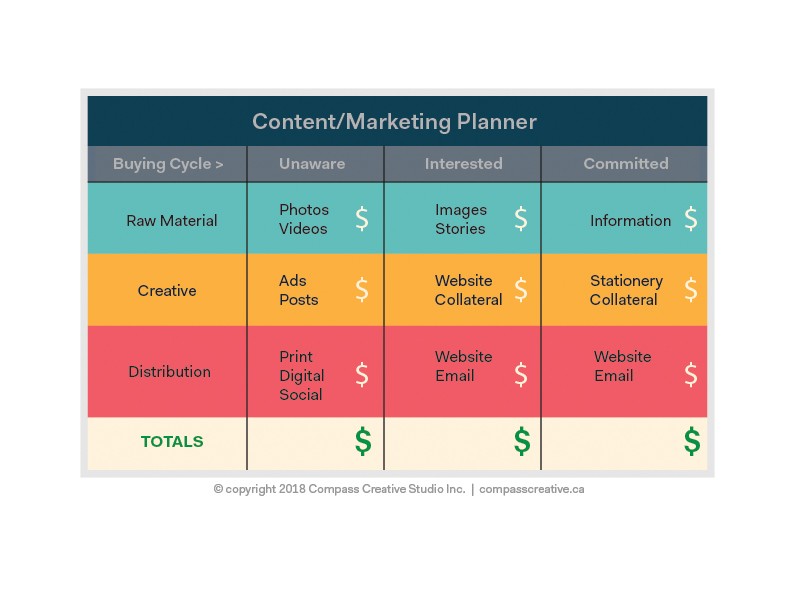Industry Insights
How to Win More Business with Great Content

If you’re like many of our clients, you might feel a little overwhelmed when you start thinking about creating content for websites, social media, blogs and the like.
We understand. Too often, we have well-meaning, hard-working clients coming in who are making the same mistakes over and over again in their marketing, often without realizing it. They’ll tell us that they’ve heard from a friend that one particular thing worked for them in their marketing — a silver bullet. But it’s never that simple. Because content comes in so many different forms, it’s easy to jump into action without thinking about an overarching strategy or plan. These tactics might occasionally work, but ultimately they fail, and business suffers.
Remember that iconic scene from the 2002 Spiderman movie, when Uncle Ben tells his nephew Peter Parker (also known as Spiderman) that “with great power comes great responsibility”?
At Compass, we believe that this same philosophy applies to marketing. Marketing is about helping others make good decisions. Businesses have a responsibility to share ethical, worthwhile and truthful content with their customers.
This is why we’ve created a tool which we’ve (quite ingeniously) dubbed the “content mixer”. We call it this because it’s like a concrete mixer: add in different variables and raw materials into a continuously revolving process, and voila — you have concrete! Er... content.
There are three steps that we walk our clients through in order to help them succeed at content marketing — and win more customers while they’re at it:
- Create a plan
- Gather raw material
- Interact with the right customers in the right place (at the right time)
Step one: Create a plan
Content is any information designed and created for consumption. In [a previous blog post](https://compasscreative.ca/blog/tailoring-content-for-your-audience), we covered how to tailor content for your audience so that it’s relevant, valuable and consistent. But how well your content resonates with your audience depends on how you plan.Content planning is the same thing as marketing planning. And it’s being done the same way it was being done before the internet existed. The medium and the channels have just shifted.
In 1996, Bill Gates made some bold statements in an essay he published online. He said that “one of the exciting things about the Internet is that anyone with a PC and a modem can publish whatever content they can create.” And that “no company is too small to participate.” This led many to believe that creating quality content was simple. But it’s actually quite complicated. It can be hard work. It can be done… but you need to plan!
This starts with our concrete… er, content mixer tool. Together, we’ll help budget and schedule your marketing. We’ll group your content into types, and look at how its being delivered. We’ll make sure you have the raw material you need to create the right content for the right places.
But how does that work? And what do we mean when we say “raw material”?

Step two: Gather raw material
For our landscapers and contractors out there, this will be a helpful analogy. Like any building or construction project, there needs to be raw material in place before anything can happen. You can’t make a pathway without screening gravel to lay bricks or stone on. You can’t grow a garden (well) without mulch or topsoil. You can’t frame without lumber.Content is no different. There needs to be raw material in place before content can be constructed or created. This is where the “concrete mixer” analogy comes full circle — our content mixer tool takes raw material and mixes it with a strong, comprehensive strategy — allowing content to be used and repurposed over and over again.
There are two main types of raw material when it comes to content: visual content and written content. At Compass, we often refer to these as assets. Visual assets include logos, icons, photography and videography. Within photography and videography, there are many subcategories, such as product photos, before and after photos, project photos, promotional videos and even photos of your team members! Written content takes many forms as well, including testimonials, product descriptions, sales letters, website copy, and yes… social media posts.
Every business or organization should have piles of raw material to draw from in order for their marketing to succeed. When a strong content plan is in place, written and visual assets can be repurposed in a host of different ways, and reused to respond to where a customer is at in the buying cycle. With proper budgeting, a list of projects, a calendar and some planning, you can succeed at content marketing. Which brings us to...
Step three: Interact with your customers at the right place (at the right time)
Before your customers part with their money, they go through multiple, distinct stages. These stages are often called the buying cycle. For each stage in the buying cycle, there is a step the customer needs to take in order to purchase your product or service. The end goal is movement — getting your customer to move from stage to stage so that they become conversions.Here are three stages that your customers will go through and the content type that is appropriate to each stage:
- Unaware: Otherwise known as the “status quo”. Potential customers have never heard of your product, service, or even your business. At this point, your content should interrupt your customers, but do it politely. The main goal in this stage is to draw their attention and build brand awareness, and this goal can be measured through clicks, impressions or website visits. Specific content types for this stage include news and public relations pieces, as well as entertainment and success stories.
- Interested: Your potential customer has heard about you and is starting to lean towards conversion! Now, the goal is lead generation. While you work towards getting leads, you’re also building trust between your business and your potential customer. At this point, you’re looking for lead qualification metrics such as form fill-outs and phone calls. Content should inspire — drawing customers towards your portfolio of work, information about your product and customer/client testimonials. Use language and imagery that shows the benefits of your product or service!
- Committed: It’s time for conversion! And along with that… revenue! The customer has made a commitment to buying your product. At this stage, buyers will be reading your website’s “about” page to learn more about you. They’re reading up on products, how the products can add value to their lives, and how to buy them. Your content for this stage should inform. All of the awareness and trust you’ve built in the previous two stages comes to the forefront here. The main metric here is total unique sales conversions.
A bonus (and a byproduct) of customers going through this cycle successfully is loyalty. When you introduce your business to the right people, communicate consistently and truthfully, and deliver on the promises you make, customers start to become loyal to your product or service — returning again and again as new leads. When this happens, your content needs to be reassuring, showing gratitude and affirmation. You’re thrilled that a valued customer has chosen you, and you want to reaffirm their decision to stick with you! Customers will be asking themselves if they’ve made the right choice, and your content should tell them that they have. You can measure customer loyalty through the number of transactions each customer has with your business over a specific time period.
Throughout the buying cycle, it’s good to remind yourself that what matters most is not what form your content comes in (i.e. video, text, audio) or what channel it is on (i.e. website, social media) — but whether or not the content speaks to the stage your audience is at. Your content should create as many points of entry to your website, and therefore your business, as possible. This is where strategy comes into play. While it’s tempting to post great content to every available platform, consideration into which ones will be the most effective and which channels to optimize is key — we call this content distribution.
In today’s day and age, everyone has incredible publishing power at their fingertips. As we mentioned earlier, here at Compass we believe that “with great power comes great responsibility”. The winners of the content marketing game will be those who produce ethical, worthwhile, truthful content that both informs and inspires. So, next time you’re feeling overwhelmed about marketing, remember that there are simple steps you can take to help you (and your business) succeed. We can help you — in fact, we want to help you — win more customers over with amazing content. Just give us a shout!

Written by Jason Bouwman, RGD
May 11, 2018


